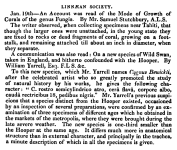Garsault used uninominal names (which have been interpreted as generic names) to denote entities that he must obviously have regarded as species, rather than as supraspecific groups.
In the case of
Cygnus, he was explicit in his text that "
Cygnus" / "Cygne" was possibly better named "Cygne privé" because "another species" existed (which implies that he understood "
Cygnus" / "Cygne", in the first pace, as applying to the species he was writing about, not to a higher-ranked group that would also have included that "other species").
On his
plate 692, he had a species (the House Sparrow) called
"Passer" and another one (the Wren) called "
Passer troglodytes"; everything (be it on the plate itself or
in the text describing this plate) suggests that he saw these two names as denoting two distinct entities of identical rank (i.e., two species); nothing suggests that he understood the first name as generic, and therefore as encompassing the taxon denoted by the second name.
On his mammal plates, in a number of case, he even used uninominal (i.e., "generic") names to denote things that he could not conceivably have regarded as anything but the male and female of a single species --
"Bos" / "Vacca",
"Hircus" / "Capra",
"Cervus" / "Cerva" (but then
"Cervus rangifer", with a modifier, was another species),
"Aries" / "Ovis",
"Homo" / "Mulier".
He also used many obviously polynominal names for plants -- things like "
Helleborus niger flore roseo", "
Serpentaria virginiana nigra", etc. --, although, admittedly, not for animals.





